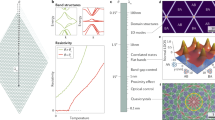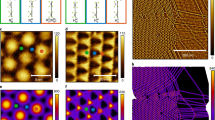Abstract
Moiré patterns result from setting a 2D material such as graphene on another 2D material with a small twist angle or from the lattice mismatch of 2D heterostructures. We present a continuum model for the elastic energy of these bilayer moiré structures that includes an intralayer elastic energy and an interlayer misfit energy that is minimized at two stackings (disregistries). We show by theory and computation that the displacement field that minimizes the global elastic energy subject to a global boundary constraint gives large alternating regions of one of the two energy-minimizing stackings separated by domain walls.
We derive a model for the domain wall structure from the continuum bilayer energy and give a rigorous asymptotic estimate for the structure. We also give an improved estimate for the \(L^{2}\)-norm of the gradient on the moiré unit cell for twisted bilayers that scales at most inversely linearly with the twist angle, a result which is consistent with the formation of one-dimensional domain walls with a fixed width around triangular domains at very small twist angles.














Similar content being viewed by others
Notes
Note that in [1] the GSFE profile across the domain wall is approximated by the sine-Gordon potential \(\Phi (\Delta u) = \frac{V_{\text{SP}}}{2} (1 - \cos (2\pi \Delta u))\) for \(0 \leqslant \Delta u \leqslant 1\) allowing for an explicit solution, and a different normalization was used with \(k = \Phi [0] - \Phi _{\min}\) the saddle point energy, resulting in a slightly different expression for the thickness of the domain wall.
References
Alden, J.S., Tsen, A.W., Huang, P.Y., Hovden, R., Brown, L., Park, J., Muller, D.A., McEuen, P.L.: Strain solitons and topological defects in bilayer graphene. Proc. Natl. Acad. Sci. USA 110(28), 11256–11260 (2013)
Bistritzer, R., MacDonald, A.H.: Moiré bands in twisted double-layer graphene. Proc. Natl. Acad. Sci. USA 108(30), 12233–12237 (2011)
Cancès, E., Cazeaux, P., Luskin, M.: Generalized Kubo formulas for the transport properties of incommensurate 2D atomic heterostructures. J. Math. Phys. 58, 063502 (2017)
Cao, Y., Fatemi, V., Demir, A., Fang, S., Tomarken, S.L., Luo, J.Y., Sanchez-Yamagishi, J.D., Watanabe, K., Taniguchi, T., Kaxiras, E., Ashoori, R.C., Jarillo-Herrero, P.: Correlated insulator behaviour at half-filling in magic-angle graphene superlattices. Nature 556(7699), 80–84 (2018)
Cao, Y., Fatemi, V., Fang, S., Watanabe, K., Taniguchi, T., Kaxiras, E., Jarillo-Herrero, P.: Unconventional superconductivity in magic-angle graphene superlattices. Nature 556(7699), 43–50 (2018)
Carr, S., Massatt, D., Torrisi, S.B., Cazeaux, P., Luskin, M., Kaxiras, E.: Relaxation and domain formation in incommensurate 2D heterostructures. Phys. Rev. B 98, 224102 (2018). (7 pp)
Cazeaux, P., Luskin, M., Massatt, D.: Energy minimization of two dimensional incommensurate heterostructures. Arch. Ration. Mech. Anal. 235(2), 1289–1325 (2020)
Dai, S., Xiang, Y., Srolovitz, D.J.: Structure and energetics of interlayer dislocations in bilayer graphene. Phys. Rev. B 93(8), 085410 (2016)
Dai, S., Xiang, Y., Srolovitz, D.J.: Twisted bilayer graphene: Moiré with a twist. Nano Lett. 16(9), 5923–5927 (2016)
Engelke, R., Yoo, H., Carr, S., Xu, K., Cazeaux, P., Allen, R., Mier Valdivia, A., Luskin, M., Kaxiras, E., Kim, M., Hoon Han, J., Kim, P.: Topological nature of dislocation networks in two-dimensional moiré materials. Phys. Rev. B 107, 125413 (2023)
Etter, S., Massatt, D., Luskin, M., Ortner, C.: Modeling and computation of Kubo conductivity for 2D incommensurate bilayers. Multiscale Model. Simul. 18, 1525–1564 (2020)
Jendrej, J., Kowalczyk, M., Lawrie, A.: Dynamics of strongly interacting kink-antikink pairs for scalar fields on a line. Duke Math. J. 171, 3643–3705 (2022)
Massatt, D., Carr, S., Luskin, M.: Electronic observables for relaxed bilayer 2D heterostructures in momentum space. (2021). arXiv:2109.15296
Massatt, D., Carr, S., Luskin, M., Ortner, C.: Incommensurate heterostructures in momentum space. Multiscale Model. Simul. 16, 429–451 (2018)
Massatt, D., Luskin, M., Ortner, C.: Electronic density of states for incommensurate layers. Multiscale Model. Simul. 15, 476–499 (2017)
Sinner, A., Pantaleón, P.A., Guinea, F.: Strain induced quasi-unidimensional channels in twisted moiré lattices (2022). arXiv:2210.07262
Walet, N.R., Guinea, F.: The emergence of one-dimensional channels in marginal-angle twisted bilayer graphene. 2D Mater. 7(1), 015023 (2019)
Watson, A.B., Kong, T., MacDonald, A.H., Luskin, M.: Bistritzer-MacDonald dynamics in twisted bilayer graphene. J. Math. Phys. 64, 031502 (2023)
Yoo, H., Engelke, R., Carr, S., Fang, S., Zhang, K., Cazeaux, P., Hyun Sung, S., Hovden, R., Tsen, A.W., Taniguchi, T., Watanabe, K., Yi, G.-C., Kim, M., Luskin, M., Tadmor, E.B., Kaxiras, E., Kim, P.: Atomic and electronic reconstruction at van der Waals interface in twisted bilayer graphene. Nat. Mater. 18, 448–453 (2019)
Zhou, S., Han, J., Dai, S., Sun, J., Srolovitz, D.J.: Van der waals bilayer energetics: Generalized stacking-fault energy of graphene, boron nitride, and graphene/boron nitride bilayers. Phys. Rev. B 92, 155438 (2015)
Zhu, Z., Cazeaux, P., Luskin, M., Kaxiras, E.: Modeling mechanical relaxation in incommensurate trilayer van der Waals heterostructures. Phys. Rev. B 101, 224107 (2020). (14 pp)
Funding
PC’s research was supported in part by National Science Foundation Award DMS-189220 and Simons Collaboration Grants for Mathematicians No. 966604. DC’s research was supported in part by National Science Foundation Award DMS-1906129. RE’s and PK’s research was supported in part by National Science Foundation Award DMREF Award No. 1922165. ML’s research was supported in part by National Science Foundation Award DMREF Award No. 1922165 and Simons Targeted Grant Award No. 896630.
Author information
Authors and Affiliations
Contributions
P.C. and M.L. wrote the main manuscript text, D.C. and P.C. did the numerical simulations, and R.E. and P.K. did the experiments.
Corresponding author
Ethics declarations
Competing interests
The authors declare no competing interests.
Additional information
Publisher’s Note
Springer Nature remains neutral with regard to jurisdictional claims in published maps and institutional affiliations.
Rights and permissions
Springer Nature or its licensor (e.g. a society or other partner) holds exclusive rights to this article under a publishing agreement with the author(s) or other rightsholder(s); author self-archiving of the accepted manuscript version of this article is solely governed by the terms of such publishing agreement and applicable law.
About this article
Cite this article
Cazeaux, P., Clark, D., Engelke, R. et al. Relaxation and Domain Wall Structure of Bilayer Moiré Systems. J Elast 154, 443–466 (2023). https://doi.org/10.1007/s10659-023-10013-0
Received:
Accepted:
Published:
Issue Date:
DOI: https://doi.org/10.1007/s10659-023-10013-0




